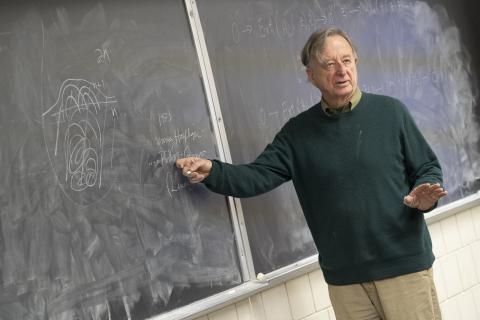Dennis Parnell Sullivan

Topology was born in the late 19th century, as a new, qualitative approach to geometry. In topology a circle and a square are the same, but the surface of the earth and that of a donut are different. Developing a precise language and quantitative tools for measuring the properties of objects that do not change when they are deformed has been invaluable throughout mathematics and beyond, with significant applications in fields ranging from physics to economics to data science.
Dennis Sullivan has repeatedly changed the landscape of topology by introducing new concepts, proving landmark theorems, answering old conjectures and formulating new problems that have driven the field forwards. He has moved from area to area, seemingly effortlessly, using algebraic, analytic and geometric ideas like a true virtuoso.
His early work was on the classification of manifolds – spaces which cannot be distinguished from Euclidean flat space in the small, but which globally are different (for example, the surface of a sphere is, in the small, roughly a plane). Building on the work of William Browder and Sergei Novikov, he developed an algebraic topological perspective on this problem and invented some brilliant techniques to solve the problems that arise. This included the ideas of “localisation of a space at a prime” and “completion of a space at a prime”. These are ideas exported from pure algebra that provide a new language for expressing geometric phenomena, which have become tools for resolving multitudes of other problems. Nowadays it is commonplace to work at one prime at a time, using different methods for different primes.
Another of Sullivan’s breakthroughs was the study of what is left when all the primes are ignored – known as rational homotopy theory. He and Daniel Quillen gave two different complete algebraic descriptions of what is left from a space in this setting. Sullivan’s model is based on differential forms – a concept of multivariable calculus, enabling direct connection to geometry and analysis. This made a major part of algebraic topology suitable for calculation, and has proven revolutionary. The use of differential forms made it especially relevant to algebraic geometry in combination with Hodge theory, as is shown in Sullivan’s work with Pierre Deligne, Phillip Griffiths and John Morgan.
To understand smooth manifolds, the completions were necessary, and one of the high points of his work here was his proof of the Adams conjecture, independently of Quillen. Sullivan has also drawn attention to the idea of a homotopy fixed set, formulating a central conjecture in homotopy and introducing a widely used tool. The original “Sullivan conjecture” was solved many years later by Haynes Miller.
Sullivan went on to tackle a host of topological, dynamical and analytic problems, always with the idea of a geometric structure on a space playing a central role.
He showed that the topological structure of a manifold of dimension five or more can always be promoted to a Lipschitz structure, allowing analytic methods to be brought to bear. His argument uses arithmetic groups to replace Kirby’s torus with a hyperbolic manifold immersed in Euclidean space. With Simon Donaldson, he proved such structures need not exist in dimension four.
In dynamics, Sullivan introduced a dictionary between Kleinian groups and iterated
rational maps, pivoting on the theory of measurable complex structures. He proved that rational maps have no wandering domains, solving a 60-year-old conjecture by Fatou, and brilliantly drawing a parallel with Ahlfors’ finiteness theorem. He went on to use similar methods to provide a conceptual proof of Feigenbaum’s universality for cascades of period doublings, recasting these results as the uniqueness of a smooth structure on a strange attractor. Sullivan’s dictionary, his rigidity theorem for Kleinian groups, and his a priori bounds for renormalisation are now fundamental principles in conformal dynamics.
In a subsequent return to the development of algebraic structures of manifolds, with Moira Chas, he astonished the field by finding a new invariant of manifolds. With its links to topological field theory, “string topology” has grown quickly into a field of its own.
Dennis Sullivan’s insistent probing for fundamental understanding, and his capacity to see analogues between diverse areas of mathematics and build bridges between them, has forever changed the field.